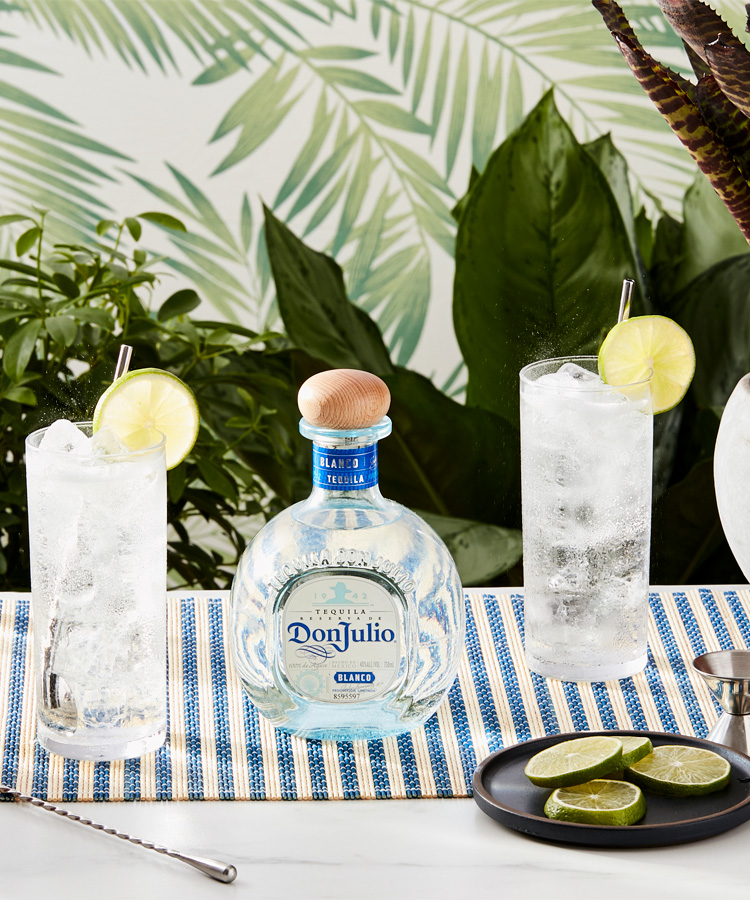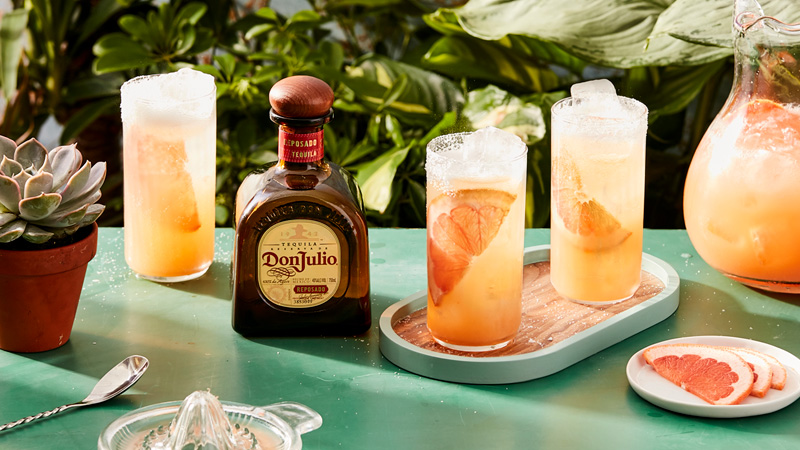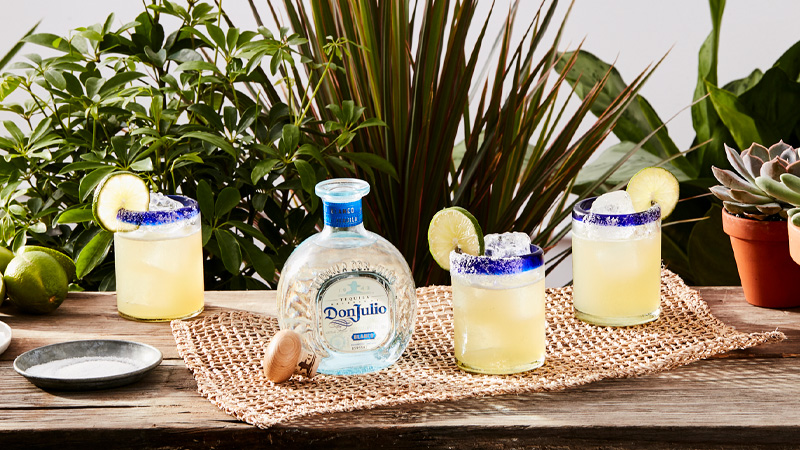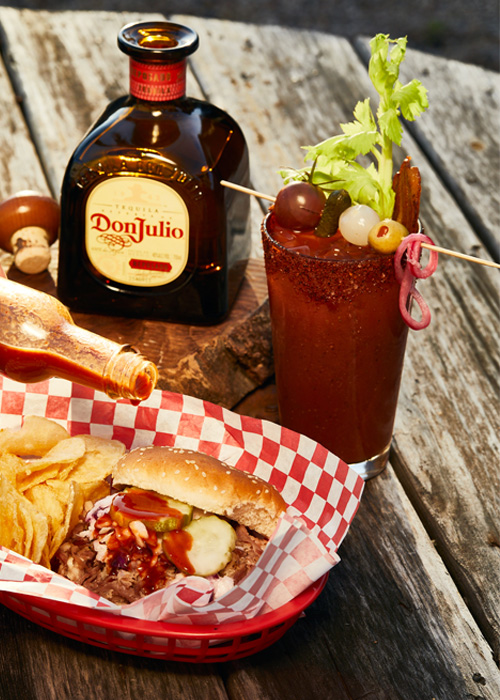
It’s probably not a shock a tequila favorite among bartenders would have a stake in the world of classic cocktails, right? Not that Don Julio’s portfolio doesn’t lend itself to some unique cocktail twists (the bee pollen-studded Turmericana, for instance). But cocktails with classic roots and Don Julio Tequila seem to go hand in hand.
That’s right in line with the Don Julio legacy—a legacy built by a young farmer, Don Julio González, who started making tequila in 1942 and founded La Primavera distillery in 1947 because he believed in the potential of agave in Mexican soil. Rooting his brand to the literal land — putting sweat and money behind his devotion, with more space between agave plantings and slower roasting — is what set Don Julio apart early on.
Of course, the best part of Don Julio is those high standards for authenticity and agave quality apply at every level still today, from Añejo and Reposado to the classic Don Julio Blanco, making it just the right ingredient for classic cocktail recipes — ones that have survived changing times and trends (and even a few tall tales).
Here are three classic cocktails that are rooted to history and lend a taste of authenticity in a time when we need it most.
La Paloma
The Paloma is an exquisitely easy recipe, the kind you can put together on the fly with a few ingredients. Its history is a bit more muddled: One story attributes its origin to hospitality legend Don Javier Delgado Corona, who ran a famous bar in the town of Tequila and also invented another soda-tequila drink, the cola-based Batanga. Another now-debunked story attributes the Paloma to a contemporary Massachusetts-based bartender, Evan Harrison, who supposedly included it in a pamphlet on the “Popular Cocktails of the Rio Grande” (except no evidence of that pamphlet exists).
It’s understandable why people wanted to claim credit for inventing it. The truth is much more poetically simple: The drink came about as an inevitability of two products meeting in time, in an evolving Mexican drinks culture. As tequila production continued to evolve in the mid-20th century — very much courtesy of brands like Don Julio — tequila eventually met up with its carbonated match made in heaven: grapefruit soda. Grapefruit soda was being developed in Mexico in the mid-1950s, at which point Don Julio González was hard at work devoting his time to his agave plants and honing his tequila-making process at La Primavera distillery. From there it was only a matter of time before grapefruit soda found its way into a glass of tequila with ice and lime — and maybe a pinch of salt.
The drink is still adored in Mexico today, with Mexicans reaching for any one of a variety of grapefruit-flavored sodas, allowing the spritely carbonation and floral bittersweetness of the grapefruit to act as a perfect complement to the tequila. It should be served in a tall glass, giving those lovely bubbles a bit of length to travel upward. Considering the increasing array of artisanal grapefruit sodas now available, there’s plenty to play with. Just keep the Don Julio handy to ensure you’re using the best ingredients.
Don Julio Blanco Margarita, a.k.a. a ‘Tommy’s Margarita’
In the U.S., the drink has been adulterated to the point where one can pull on a lever to release a sticky, frozen mix masquerading as a cocktail. Not that we don’t have room in our hearts for a frozen Margartia, but the cocktail actually has cleaner, simpler roots — spirit, sweetener, with the assertive piquancy of salt and lime — and it deserves more reverence.
If only its origin was easier to pin down: Back stories are as varied as bizarre recipe variations (Kale Margaritas, anyone?). In one version of the story, Carlos “Danny” Herrera, claims he invented the drink as a Tijuana roadside bartender catering to the finicky tastes of an aspiring dancer named Marjorie King. There’s another story of a Dallas socialite, Margarita Sames, inventing the drink during a 1948 Christmas party in Acapulco, where her dear friend Tom Hilton (you might know the name) quickly exported the drink idea onto his hotel menus (except the timing there is at least a few years too late).
The origins of the Tommy’s Margarita are exceedingly simple and lean into the drink’s Mexican heritage. Working at his parents’ now-famous restaurant bearing the same name in San Francisco in the late 1980s, Julio Bermejo swapped simple agave sweetener in for the traditional orange liqueur in his Margarita recipe. Bermejo wasn’t just bored. He’d been exploring tequilas for a better part of the decade, and wanted to create a drink that allowed the agave spirit to shine, unobstructed. The result was not only a cleaner flavor profile — delicately sweet agave notes in place of syrupy orange florals — but a return to literal roots. With just blanco tequila, lime, and agave, a Tommy’s Margarita is kinder to the essence of agave. Therefore it’s no shock Bermejo was chosen to accompany then-President of Mexico Vincente Fox on a world tour to celebrate tequila’s denomination of origin status.
For agave authenticity, the Tommy’s Margarita is the recipe to beat. It’s a purist’s cocktail, highlighting the delicacy of agave from the fresh vegetal notes of Don Julio Blanco paired with the subtle, sugary kiss of agave nectar (no levers required), as well as the clean, and nearly clear color of the drink. Plus there’s no kitschy glassware required.
The Bloody Maria
You might know the Bloody Maria as the guest of honor at a recent morning-after brunch. The drink, however, has a longer footprint, with its origins stretching all the way back to the 1920s and all the way across the pond, to Paris.
At least that’s the fabulous, if murky and convoluted background of the Bloody Mary, on which the Bloody Maria is based. There are two possible sources — a former Vaudevillian named George Jessel, who at a Palm Beach party in 1927 experimented with tomato and vodka and promptly spilled it down the dress of a fellow party guest named Mary. There’s also a bartender, Fernand Petiot, who supposedly mixed the fiery vodka favored by Russian emigrés at a Parisian bar, softened by tomato juice. That all came stateside when Petiot got behind the bar of a lauded New York hotel in 1934, and the rest is Bloody history, so to speak.
The Bloody Maria came about more recently, sometime in the 1960s (according to some historians, the first mention of it is in The Press Courier in January 1972). It’s nearly the same vibrant mix of tomato, Worcestershire, salt, pepper, and cayenne, but the fresh, spiky green heat of a tequila like Don Julio Blanco gives it more of a garden patch vibe than you’d get out of a traditional Bloody Mary. Indeed, the green notes against supple red tomato and the subtle earthiness of the Worcestershire make this a kind of spring awakening in a glass — ideal for a brunch eye-opener, of course, but just as welcome when you’re looking for something to sip that tastes fresh.
There’s a spiritual, if not historic, connection between the beloved Sangrita chaser and the Bloody Maria. In fact, among Sangrita drinkers it’s widely contested whether tomato belongs in the zest concoction in the first place (many recipes include pomegranate and orange juice, as well as chilies). But when Sangrita recipes incorporate tomato, there’s no denying the two drinks have a flavor profile in common. The Don Julio Sangrita features fresh plum tomatoes, onion, garlic, salt, pepper, and lime, making it almost a kind of Bloody Maria in miniature. (That’s apt, considering “Sangrita” literally means “little blood.”) With tomato and assertive savory seasoning and vibrant spices, the Bloody Maria and Sangrita alike act as perfect backdrops for the fresh, tender green heat of a Don Julio Blanco. It’s your choice whether you want a little Sangrita kick or a full Bloody Maria, which can be served in anything from a tall Collins glass to a sturdier Old Fashioned glass — or batched in pitchers. You’ll notice that vegetal heat instantly and promptly forget the vodka. Don Julio in the mix makes it an instant classic.
This article is sponsored by Don Julio Tequila.



